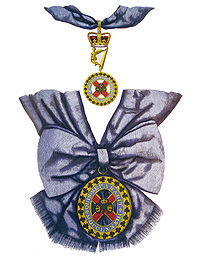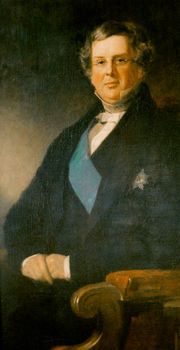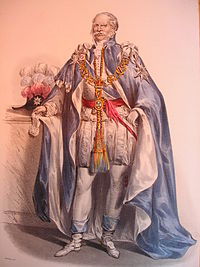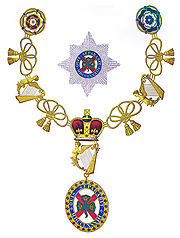
Order of St. Patrick
Did you know...
SOS Children have produced a selection of wikipedia articles for schools since 2005. Sponsoring children helps children in the developing world to learn too.
The Most Illustrious Order of Saint Patrick is a British order of chivalry associated with Ireland. The Order was created in 1783 by George III. The regular creation of knights of Saint Patrick lasted until 1921, when most of Ireland became independent as the Irish Free State. While the Order technically still exists, no knight of St Patrick has been created since 1936, and the last surviving knight, Prince Henry, Duke of Gloucester, died in 1974. The Queen, however, remains the Sovereign of the Order, and one officer, the Ulster King of Arms (now combined with Norroy King of Arms), also survives. St Patrick is patron of the order; its motto is Quis separabit?, or Latin for "Who will separate us?": an allusion to the Vulgate translation of Romans 8:35, "Who shall separate us from the love of Christ?"
Most British orders of chivalry cover the entire kingdom, but the three most exalted ones each pertain to one constituent nation only. The Order of St Patrick, which pertains to Ireland, is the most junior of these three in precedence and age. Its equivalent in England, The Most Noble Order of the Garter, is the oldest order of chivalry in the United Kingdom, dating to the middle fourteenth century. The Scottish equivalent is The Most Ancient and Most Noble Order of the Thistle, dating in its modern form to 1687.
The Order of St Patrick earned international coverage when, in 1907, its insignia, known generally as the Irish Crown Jewels, were stolen from Dublin Castle shortly before a visit by the Order's Sovereign, King Edward VII. Their whereabouts remain a mystery.
History
Foundation
The Order was founded in 1783, a year after the grant of substantial autonomy to Ireland, as a means of rewarding (or obtaining) political support in the Irish Parliament. The Order of the Bath, founded in 1725, was instituted for similar reasons. The statutes of the Order restricted membership to men who were both knights and gentlemen, the latter being defined as having three generations of "noblesse" (i.e. ancestors bearing coats of arms) on both their father's and mother's side. In practice however only Irish Peers (and occasionally foreign princes) were ever appointed to the Order. The cross of St Patrick (a red saltire on a white background) was chosen as one of the symbols of the Order. A flag of this design was later used semi-officially to represent Ireland from that time until the Act of Union 1800, when it was incorporated into the Union Flag. Its association with St. Patrick or with Ireland prior to the foundation of the Order is unclear, however. One of the first knights was the 2nd Duke of Leinster, whose arms carry the same cross.
Post-1922
The Irish Executive Council under W. T. Cosgrave chose not to keep appointing people to the Order when the Irish Free State left the United Kingdom in 1922. Since then, only three people have been appointed to the Order. All were members of the British Royal Family. The then Prince of Wales (the future King Edward VIII and later Duke of Windsor) was appointed in 1927 and his younger brothers, Henry, Duke of Gloucester in 1934 and Albert, Duke of York (later King George VI) in 1936. The Duke of Gloucester at his death in 1974 was the last surviving member of the Order. It has however never actually been abolished and its resurrection has been discussed in Irish government circles on a number of occasions.
Possible revival
Winston Churchill suggested reviving the Order in 1943 to recognise the services of General Harold Alexander in Tunisia, but the opinion of his ministers and civil servants was that it would upset the diplomatic balance between London and Dublin. Taoiseach Seán Lemass considered reviving the Order during the 1960s, but did not take a decision.
It is possible, but highly unlikely, for the British monarch to revive the Order unilaterally. It is also possible that the British monarch and the Irish government could re-establish the Order as a part of a joint Anglo-Irish honours system. The Irish Sunday Independent newspaper published an article in July 2004 urging the resurrection of the Order and the conferring of membership of the order jointly by the President of Ireland and the British monarch to individuals who had distinguished themselves in the field of Anglo-Irish relations. Other publications also made similar suggestions.
The Constitution of Ireland provides, "Titles of nobility shall not be conferred by the State" (Article 40.1) and "No title of nobility or of honour may be accepted by any citizen except with the prior approval of the Government" (Article 40.2). Legal experts are divided on whether this clause prohibits the awarding of membership of the Order of St Patrick to Irish citizens, but some suggest that the phrase "titles of nobility" implies hereditary peerages and other noble titles, not lifetime honours such as knighthoods.. In any case, a reigning monarch of the United Kingdom would require the approval of the Government of Ireland to award an Irish citizen in this manner.
Composition
Members
The British monarch is Sovereign of the Order of St Patrick. The Lord Lieutenant of Ireland, the monarch's representative in Ireland, served as the Grand Master. The office of Lord Lieutenant was abolished in 1922; the last Lord Lieutenant and Grand Master was Edmund Fitzalan-Howard, 1st Viscount Fitzalan of Derwent.
The Order originally consisted of fifteen knights in addition to the Sovereign. In 1821, however, George IV appointed six additional knights; he did not issue a Royal Warrant authorising the change until 1830. William IV formally changed the statutes in 1833, increasing the limit to twenty-two knights.
The original statutes, based heavily on those of the Order of the Garter, prescribed that any vacancy should be filled by the Sovereign upon the nomination of the members. Each Knight was to propose nine candidates, of whom three had to have the rank of Earl or higher, three the rank of Baron or higher, and three the rank of Knight or higher, and a vote taken. In practice this system was never used; the Grand Master would nominate a Peer, the Sovereign would usually assent, and a chapter meeting held at which the knights "elected" the new member. The Order of St Patrick differed from its English and Scottish counterparts, the Orders of the Garter and the Thistle, in only ever appointing peers and princes. Women were never admitted to the Order of St Patrick; they were not eligible to become members of the other two orders until 1987. The only woman to be part of the Order was Queen Victoria as Sovereign of the Order. Although associated with the established Church of Ireland until 1871, several Catholics were appointed to the order throughout its history.
Officers
The Order of St Patrick initially had thirteen officers: the Prelate, the Chancellor, the Registrar, the Usher, the Secretary, the Genealogist, the King of Arms, two heralds and four pursuivants. Many of these offices were held by clergymen of the Church of Ireland, then established church. After the disestablishment of the Church in 1871, the ecclesiastics were allowed to remain in office until their deaths, when the offices were either abolished or reassigned to lay officials. All offices except that of Registrar and King of Arms are now vacant.
The office of Prelate was held by the Archbishop of Armagh, the most senior clergyman in the Church of Ireland. The Prelate was not mentioned in the original statutes, but created by a warrant shortly afterwards, apparently because the Archbishop at the time had asked to be appointed to the post. Since the death of the last holder in 1885, the office of Prelate has remained vacant.
The Church of Ireland's second highest cleric, the Archbishop of Dublin, originally served as the Chancellor of the Order. From 1886 onwards, the office was held instead by the Chief Secretary for Ireland. Since the abolition of the position of Chief Secretary in 1922, the office of Chancellor has remained vacant.
The Dean of St Patrick's Cathedral was originally the Registrar of the Order. In 1890, on the death of the Dean who had held the post in at the time of disestablishment, the office was attached to that of the King of Arms of the Order. This position was held by Ulster King of Arms, Ireland's chief heraldic official, a post which had been created in 1552. In 1943, this post was in effect divided in two, reflecting the partition of Ireland in the Government of Ireland Act, 1920. The position, insofar as it related to Northern Ireland, was combined with that of Norroy King of Arms (who had heraldic jurisdiction in the north of England). The post of Norroy and Ulster King of Arms still exists, and thus continues to hold the offices of Registrar and King of Arms of the Order of St Patrick. The office of Ulster King of Arms, insofar as it related to the Irish Free State (now the Republic of Ireland), became the position of Chief Herald of Ireland.
The Order of St Patrick had six other heraldic officers, many more than any other British order. The two heralds were known as Cork Herald and Dublin Herald. Three of the four pursuivancies were untitled, the fourth was held by Athlone Pursuivant, an office founded in 1552.
The Usher of the Order was "the Usher at Arms named the Black Rod". The Irish Gentleman Usher of the Black Rod was distinct from the English officer of the same name, though like his counterpart he had some duties in the Irish House of Lords. (The latter continues to serve as Usher to the Order of the Garter and as Serjeant-at-Arms of the House of Lords.) The Irish post has been vacant since 1933.
The offices of Secretary and Genealogist were originally held by members of the Irish House of Commons. The office of Secretary has been vacant since 1926. The position of Genealogist was left vacant in 1885, restored in 1889, but left vacant again in 1930.
Current members and officers
- Sovereign: Elizabeth II
- Registrar and King of Arms: Thomas Woodcock Esq. LVO ( Norroy and Ulster King of Arms)
Vestments and accoutrements
For important occasions, such as coronations and investitures of new members of the Order, Knights of St Patrick wore elaborate vestments:
- The mantle was a celestial blue robe lined with white silk. The star of the Order (see below) was depicted on the left of the mantle. A blue hood was attached to the mantle.
- The hat of the Order was originally of white satin, lined with blue, but was changed to black velvet by George IV. It was plumed with three falls of feathers, one red, one white and one blue.
- The collar was made of gold, consisting of Tudor roses and harps attached with knots. The two roses which comprise the Tudor rose were alternately enamelled white within red, and red within white. The central harp, from which the badge of the Order was suspended, was surmounted by a crown.
Aside from these special occasions, however, much simpler accoutrements were used:
- The star of the Order was an eight-pointed figure, with the four cardinal points longer than the intermediate points. Each point was shown as a cluster of rays. In the centre was the same motto, year and design that appeared on the badge. The star was worn pinned to the left breast.
- The broad riband was a celestial blue sash worn across the body, from the left shoulder to the right hip.
- The badge was pinned to the riband at the right hip (or, when collars are worn, suspended from the collar). Made of gold, it depicted a shamrock bearing three crowns, on top of a cross of St Patrick and surrounded by a blue circle bearing the motto in majusclues, as well as the date of the Order's foundation in Roman numerals ("MDCCLXXXIII").
The Grand Master's insignia were of the same form and design as those of the Knights. In 1831, however, William IV presented the Grand Master with a star and badge, each composed of rubies, emeralds and Brazilian diamonds. These two insignia became known as the Irish Crown Jewels. They, along with five collars belonging to Knights, were famously stolen in 1907; they have not since been recovered.
A number of items pertaining to the Order of St Patrick are held in museums in the Republic of Ireland and Northern Ireland. The robes of Luke Gerald Dillon, 4th Baron Clonbrock, the 122nd Knight of the Order are on display in the National Museum of Ireland, Dublin; the robe belonging to Francis Charles Needham, 3rd Earl of Kilmorey is held by the Newry Museum; the National Gallery and Genealogical Museum in Dublin both have Stars of the Order; and the National Museum and Galleries of Northern Ireland Ulster Museum has a large collection on display and two mantles in storage. The Irish Guards take their capstar and motto from the Order.
Chapel and Chancery
The Chapel of the Order was originally in St Patrick's Cathedral, Dublin. Each member of the Order, including the Sovereign, was allotted a stall in the choir of the Chapel, above which his (or her, in the case of Queen Victoria) heraldic devices were displayed. Perched on the pinnacle of a knight's stall was a helm, decorated with mantling and topped by his crest. Above the crest, the knight's heraldic banner was hung, emblazoned with his coat of arms. At a considerably smaller scale, to the back of the stall was affixed a piece of brass (a "stall plate") displaying its occupant's name, arms and date of admission into the Order. Upon the death of a Knight, the banner and crest were taken down and replaced with those of his successor. After the disestablishment of the Church of Ireland in 1871, the Chapel ceased to be used; the heraldic devices of the knights at the time were left in place at the request of Queen Victoria.
The Order was without a ceremonial home until 1881 when arrangements were made to display banners, helms and hatchment plates (the equivalent of stall plates, in the absence of stalls) in the Great Hall of Dublin Castle. On the establishment of the Irish Free State the banners of the living knights were removed. When the Hall was redecorated in 1962 it was decided that it should be hung with the banners of the members of the Order in 1922. The existing banners were repaired or new ones made; it is these banners which can be seen today. The Hall, which was renamed St Patrick's Hall from its association with the Order, also served as the Chancery of the Order. Installation ceremonies, and later investitures, were held here, often on St Patrick's Day, until they were discontinued. A banquet for the Knights was often held in the Hall on the occasion of an installation. St Patrick's Hall now serves as the location for the inauguration of the President of Ireland.
Unlike many of the other British Orders the stall plates (or hatchment plates) do not form a continuous record of the Knights of the Order. There are only 34 stall plates for the 80 or so knights appointed before 1871, (although others were destroyed in a fire in 1940), and 40 hatchments plates for the 60 knights appointed subsequently. In the case of the stall plates this was perhaps due to the their size, 30x36 cm (12x14 in).
Precedence and privileges
Since the members of the Order were required to be knights, and in practice had higher rank, many of the privileges of membership were rendered moot. As knights they could prefix "Sir" to their forenames, but the form was never used in speech, as they were referred to by their peerage dignities. They were assigned positions in the order of precedence, but had higher positions by virtue of their peerage dignities.
Knights used the post-nominal letters "KP". When an individual was entitled to use multiple post-nominal letters, KP appeared before all others, except "Bt" ( Baronet), "VC" (Victoria Cross), "GC" ( George Cross), "KG" (Knight of the Garter) and "KT" (Knight of the Thistle).
Knights could encircle their arms with a depiction of the circlet (a blue circle bearing the motto) and the collar; the former is shown either outside or on top of the latter. The badge is depicted suspended from the collar. They were also entitled to receive heraldic supporters. This high privilege was, and is, only shared by members of the Royal Family, peers, Knights and Ladies of the Garter, Knights and Ladies of the Thistle, and Knights and Dames Grand Cross and Knights Commanders of the junior orders. (Of course, Knights of St Patrick, all being members of the Royal Family or peers, were entitled to supporters in any event.)








